A Dark, A Light, A Bright: The Designs of Dorothy Liebes

A Dark, A Light, A Bright: The Designs of Dorothy Liebes is the first monographic exhibition in more than 50 years on designer and weaver Dorothy Liebes (1897–1972). Among the most influential designers of the 20th century, Liebes shaped American tastes in areas from interiors and transportation to industrial design, fashion, and film.
From the 1930s through the 1960s, Liebes developed and popularized a distinctively American form of midcentury design—one that combined handcraft with newly developed materials and brilliant color. Few people wielded as much influence over the textures and colors of modern architectural interiors. Liebes collaborated with some of the most prominent architects and designers of the time, including Frank Lloyd Wright, Henry Dreyfuss, Donald Deskey, Raymond Loewy, and Samuel Marx, on commissions ranging from Doris Duke’s Honolulu home, Shangri La, to the United Nations Delegates Dining Room. Fashion designers, including Pauline Trigère, Adrian, and Bonnie Cashin, also used her fabrics, yielding some of the most distinctively American fashions of the mid-twentieth century. Her luxurious handwoven fabrics combined vivid color, lush textures, unexpected materials, and a glint of metallic—a style that grew so prevalent it became known as the “Liebes Look.”
Liebes believed that industrial production assured the greatest possible access to quality design and that handcraft had a role to play in it. In the 1950s, she gave up custom fabrics production to focus on creating handwoven samples for interpretation on power looms. Her studio became a laboratory for design where she and her team of weavers explored the capabilities of new, synthetic materials. The “Liebes Look” penetrated every market and every price point.
Through television and radio appearances and her near-constant presence in shelter and women’s magazines, Liebes became a highly visible and respected design authority. She had an outsized influence on how many Americans experienced modern design; despite widespread recognition during her lifetime, the impact of her long and productive career has been largely overlooked. Her story adds an essential missing thread to the narrative of midcentury modernism.
On view July 7, 2023 through February 4, 2024, reserve your tickets here.
ACKNOWLEDGMENTS
A Dark, A Light, A Bright: The Designs of Dorothy Liebes is made possible by The Coby Foundation; The Decorative Arts Trust; the Smithsonian American Women’s History Initiative, a program of the Smithsonian American Women’s History Museum; and the Terra Foundation for American Art.
The project received Federal support from the Smithsonian Collections Care and Preservation Fund, administered by the National Collections Program and the Smithsonian Collections Advisory Committee.
Generous support is provided by the Lily Auchincloss Foundation; the Lenore G. Tawney Foundation; Mergentime Family Archive; and the Samuel H. Kress Foundation, administered by the Foundation for Advancement in Conservation.
Support is also provided by Elizabeth Whelan, The Josef and Anni Albers Foundation, and Patsy Orlofsky.
Additional support for the publication is provided by the Andrew Mellon Foundation Publications Fund and Furthermore: a program of the J.M. Kaplan Fund.
EXHIBITION
A Dark, A Light, A Bright: The Designs of Dorothy Liebes is organized by Susan Brown, Associate Curator and Acting Head of Textiles at Cooper Hewitt, and Alexa Griffith Winton, Manager of Content and Interpretation at Cooper Hewitt.
On view July 7, 2023 through February 4, 2024, the exhibition features more than 175 works, including textiles, textile samples, fashion, furniture, documents, and photographs. For more information and to purchase tickets, click here.
Exhibition and graphic design are by Isometric Studio.






Objects from the Exhibition
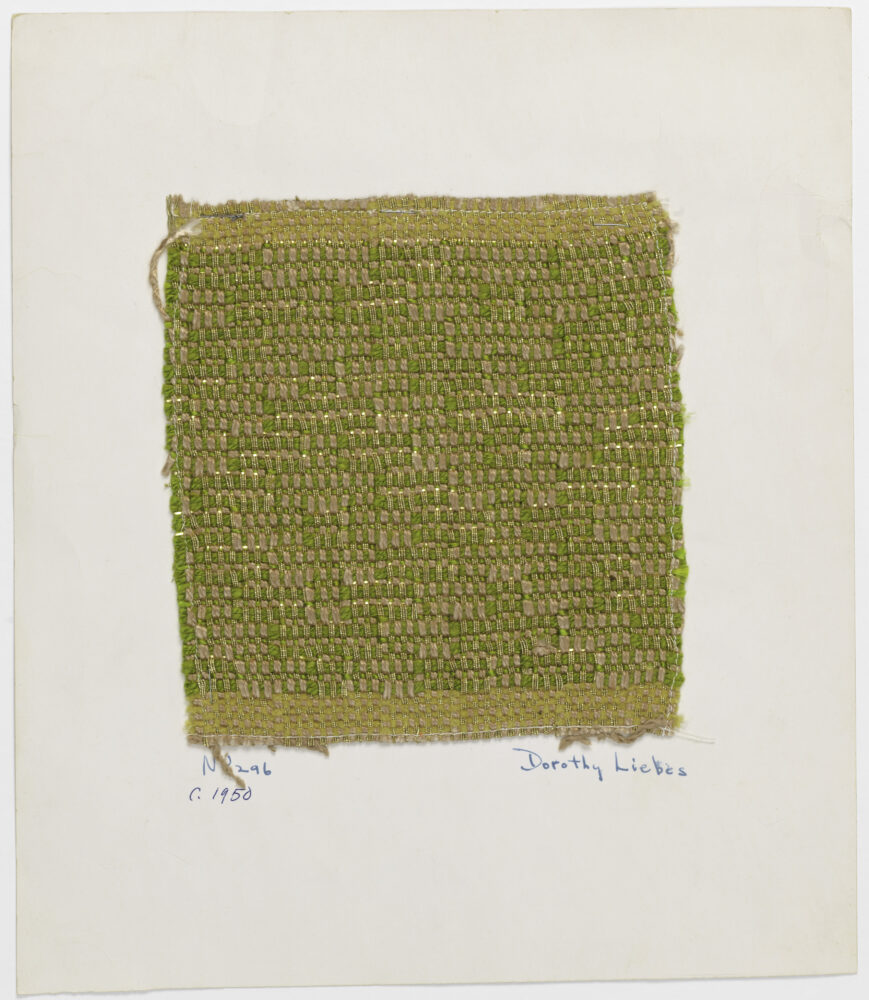
Sample card, circa 1950; Designed by Dorothy Wright Liebes (American, 1897–1972); Plain-woven cotton, viscose rayon, silk, cellulose acetate butyrate–laminated aluminum yarn; Cooper Hewitt, Smithsonian Design Museum, Gift of the Estate of Dorothy Liebes Morin, 1972-75-81; Photo by Matt Flynn © Smithsonian Institution

Sample card, circa 1940; Designed by Dorothy Wright Liebes (American, 1897–1972); Twill-woven cotton, silk, wool; Cooper Hewitt, Smithsonian Design Museum, Gift of the Estate of Dorothy Liebes Morin, 1972-75-23; Photo by Matt Flynn © Smithsonian Institution

Sample card, circa 1953; Designed by Dorothy Wright Liebes (American, 1897–1972); Twill-woven cotton, viscose rayon, silk, silk-rayon blend, wool; Cooper Hewitt, Smithsonian Design Museum, Gift of the Estate of Dorothy Liebes Morin, 1972-75-89; Photo by Matt Flynn © Smithsonian Institution

Mexican Plaid textile, circa 1938; Designed by Dorothy Wright Liebes (American, 1897–1972); Twill-woven wool, cotton, silk, viscose rayon, nylon, cellulose triacetate, viscose rayon–cellulose triacetate blend, cellulose acetate– and cellulose acetate butyrate–laminated aluminum yarns, cellulose triacetate–laminated aluminum yarn, cellophane; Cooper Hewitt, Smithsonian Design Museum, Gift of the Estate of Dorothy Liebes Morin, 1972-75-1; Photo by Matt Flynn © Smithsonian Institution

Sample for a woven blind, 1952; Designed by Dorothy Wright Liebes (American, 1897–1972); Plain-woven wool, viscose rayon, nylon, silk, cotton, cellulose acetate butyrate–laminated aluminum yarns, polyester-laminated aluminum yarns, painted wood; Cooper Hewitt, Smithsonian Design Museum, Gift of Titi Halle, 2021-15-21; Photo by Matt Flynn © Smithsonian Institution

Sample for a woven blind, circa 1952; Designed by Dorothy Wright Liebes (American, 1897–1972); Plain-woven cotton, viscose rayon, silk, cellulose acetate– and cellulose acetate butyrate–laminated aluminum yarns, painted wood; Cooper Hewitt, Smithsonian Design Museum, Gift of Titi Halle, 2021-15-14; Photo by Matt Flynn © Smithsonian Institution
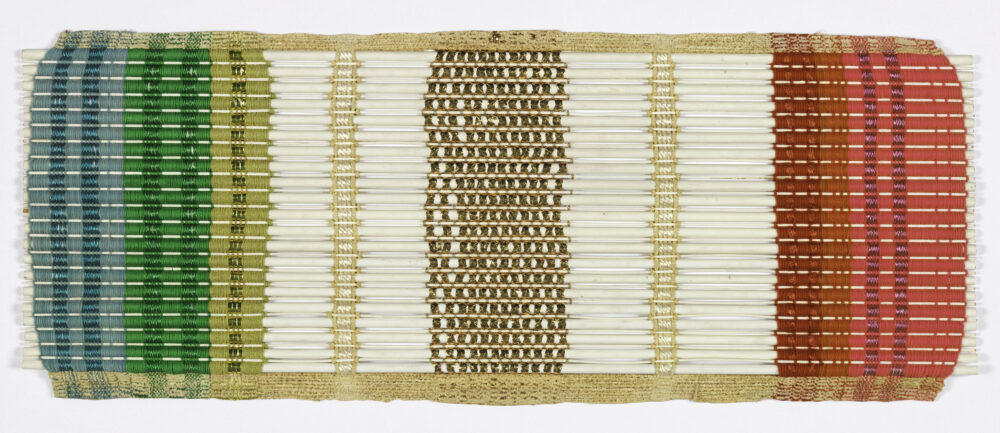
Sample for a woven blind, 1956; Designed by Dorothy Wright Liebes (American, 1897–1972); Plain-woven cellulose acetate, cotton, nylon, viscose rayon, silk, cellulose acetate– and cellulose acetate butyrate–laminated aluminum yarns, wood; Cooper Hewitt, Smithsonian Design Museum, Gift of the Estate of Dorothy Liebes Morin, 1972-75-9; Photo by Matt Flynn © Smithsonian Institution
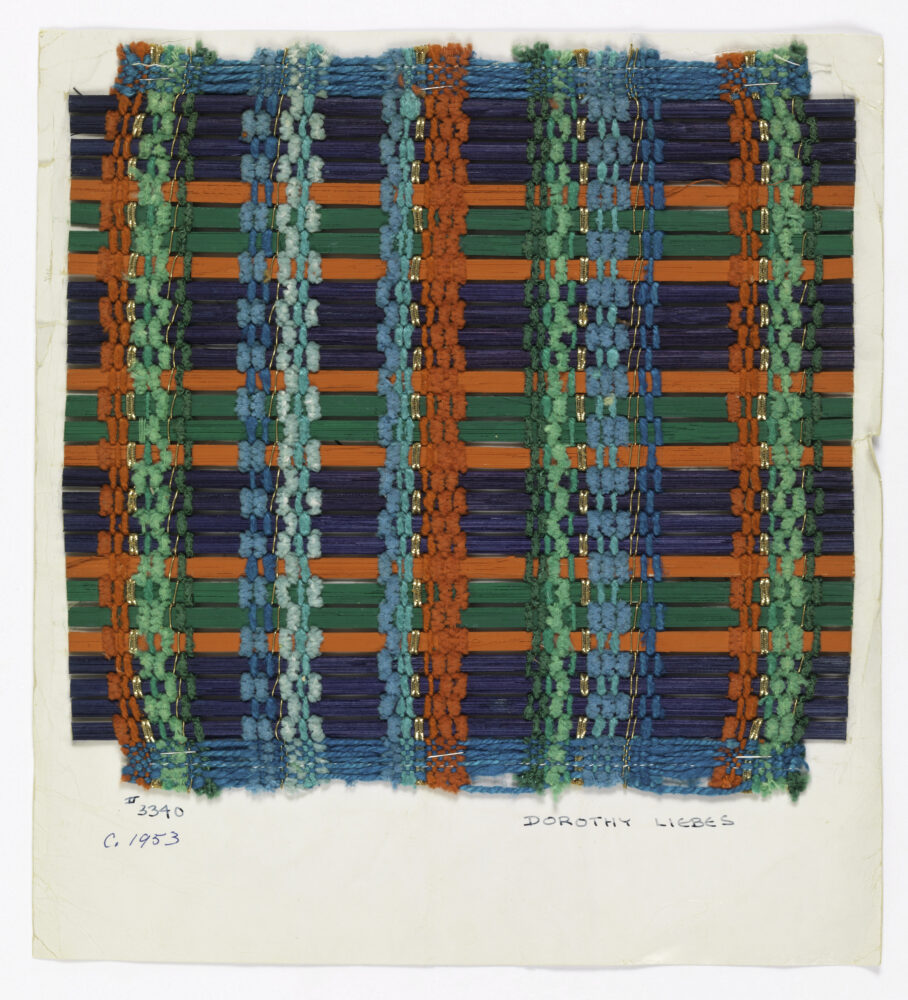
Sample card, circa 1953; Designed by Dorothy Wright Liebes (American, 1897–1972); Cotton, silk-viscose rayon blend, viscose rayon, cellulose acetate butyrate–laminated aluminum yarn, painted reed; Cooper Hewitt, Smithsonian Design Museum, Gift of the Estate of Dorothy Liebes Morin, 1972-75-124; Photo by Matt Flynn © Smithsonian Institution

Sample card, 1945; Designed by Dorothy Wright Liebes (American, 1897–1972); Cotton, viscose rayon, silk, wool, cellulose acetate butyrate–laminated aluminum yarn, reed; Cooper Hewitt, Smithsonian Design Museum, Gift of the Estate of Dorothy Liebes Morin, 1972-75-114; Photo by Matt Flynn © Smithsonian Institution

Sample card, 1947; Designed by Dorothy Wright Liebes (American, 1897–1972); Wool, viscose rayon, cotton, silk; Cooper Hewitt, Smithsonian Design Museum, Museum purchase through gift of Mrs. John Innes Kane, 1948-26-12; Photo by Matt Flynn © Smithsonian Institution

Sample card, circa 1947; Designed by Dorothy Wright Liebes (American, 1897–1972); Cotton, viscose rayon, silk; Cooper Hewitt, Smithsonian Design Museum, Gift of the Estate of Dorothy Liebes Morin, 1972-75-44; Matt Flynn © Smithsonian Institution

Sample for a woven blind, 1950s; Designed by Dorothy Wright Liebes (American, 1897–1972); Plain-woven viscose rayon, cotton, silk, cellulose acetate–laminated aluminum yarn, cellulose acetate butyrate–laminated aluminum yarn, wood, bamboo; Cooper Hewitt, Smithsonian Design Museum, Gift of Titi Halle, 2021-15-1; Photo by Matt Flynn © Smithsonian Institution

Sample card, circa 1948; Designed by Dorothy Wright Liebes (American, 1897–1972); Twill-woven with supplementary weft cotton, viscose rayon, silk, cellulose acetate butyrate–laminated aluminum yarn; Cooper Hewitt, Smithsonian Design Museum, Gift of the Estate of Dorothy Liebes Morin, 1972-75-104; Photo by Matt Fynn © Smithsonian Institution

Sample card, circa 1948; Designed by Dorothy Wright Liebes (American, 1897–1972); Plain-woven cotton, silk, viscose rayon, reed; Cooper Hewitt, Smithsonian Design Museum, Gift of the Estate of Dorothy Liebes Morin, 1972-75-115; Photo by Matt Flynn © Smithsonian Institution

Sample card, circa 1942; Designed by Dorothy Wright Liebes (American, 1897–1972); Plain-woven cotton, viscose rayon, cellulose acetate butyrate–laminated aluminum yarn; Cooper Hewitt, Smithsonian Design Museum, Gift of the Estate of Dorothy Liebes Morin, 1972-75-27; Photo by Matt Flynn © Smithsonian Institution

Sample card, circa 1948; Designed by Dorothy Wright Liebes (American, 1897–1972); Plain-woven cotton, viscose rayon, silk, wool, cellulose acetate butyrate–laminated aluminum yarn; Cooper Hewitt, Smithsonian Design Museum, Gift of the Estate of Dorothy Liebes Morin, 1972-75-63; Photo by Matt Flynn © Smithsonian Institution
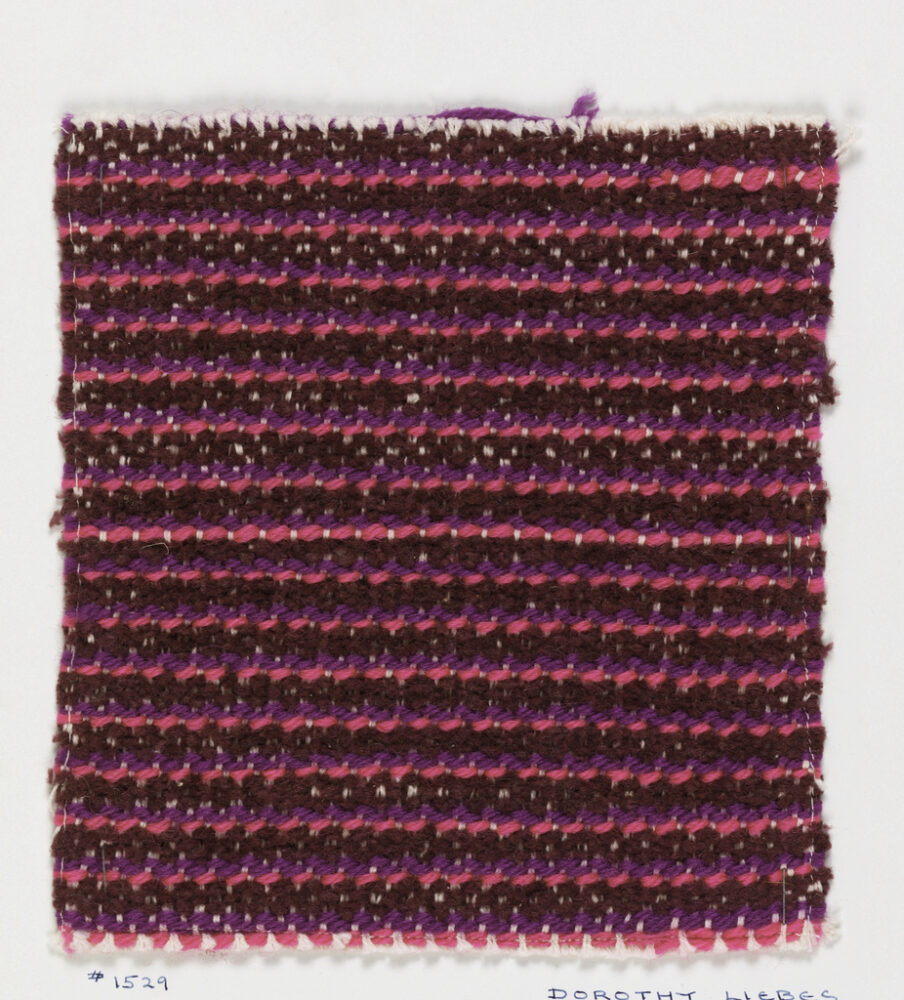
Sample card, 1947; Designed by Dorothy Wright Liebes (American, 1897–1972); Twill- and basket-woven cotton, wool; Cooper Hewitt, Smithsonian Design Museum, Gift of the Estate of Dorothy Liebes Morin, 1948-26-11; Photo by Matt Flynn © Smithsonian Institution

Sample card, circa 1935; Designed by Dorothy Wright Liebes (American, 1897–1972); Plain-and twill-woven cotton, viscose rayon, silk; Cooper Hewitt, Smithsonian Design Museum, Gift of the Estate of Dorothy Liebes Morin, 1972-75-18; Photo by Matt Flynn © Smithsonian Institution

Dobeckmun Dazzle, circa 1948; Designed by Dorothy Wright Liebes (American, 1897–1972); Twill- and pile-woven cotton, viscose rayon, cellulose acetate butyrate–laminated aluminum yarn; Cooper Hewitt, Smithsonian Design Museum, Gift of the Estate of Dorothy Liebes Morin, 1972-75-4; Photo by Matt Flynn © Smithsonian Institution

Sample card, circa 1934; Designed by Dorothy Wright Liebes (American, 1897–1972); Cotton; Cooper Hewitt, Smithsonian Design Museum, Gift of the Estate of Dorothy Liebes Morin, 1972-75-14; Photo by Matt Flynn © Smithsonian Institution

Sample card, circa 1949; Designed by Dorothy Wright Liebes (American, 1897–1972); Twill-woven cotton, nylon, silk, cellulose acetate–laminated aluminum yarn, cellulose acetate butyrate–laminated aluminum yarn; Cooper Hewitt, Smithsonian Design Museum, Gift of the Estate of Dorothy Liebes Morin, 1972-75-77; Photo by Matt Fynn © Smithsonian Institution

Sample card, circa 1955; Designed by Dorothy Wright Liebes (American, 1897–1972); Plain-woven cotton, viscose rayon, cellulose acetate–laminated aluminum yarn; Cooper Hewitt, Smithsonian Design Museum, Gift of the Estate of Dorothy Liebes Morin, 1972-75-99; Photo by Matt Fynn © Smithsonian Institution

Sample card, circa 1953; Designed by Dorothy Wright Liebes (American, 1897–1972); Plain-woven cotton, nylon, viscose rayon, cellulose acetate– and cellulose acetate butyrate–laminated aluminum yarns; Cooper Hewitt, Smithsonian Design Museum, Gift of the Estate of Dorothy Liebes Morin, 1972-75-91; Photo by Matt Fynn © Smithsonian Institution

Sample card, circa 1950; Designed by Dorothy Wright Liebes (American, 1897–1972); Plain-woven cotton, viscose rayon, cellulose acetate butyrate–laminated aluminum braid, reed; Cooper Hewitt, Smithsonian Design Museum, Gift of the Estate of Dorothy Liebes Morin, 1972-75-118; Photo by Matt Fynn © Smithsonian Institution

Sample card, circa 1954; Designed by Dorothy Wright Liebes (American, 1897–1972); Plain-woven cotton, linen, cellulose acetate–laminated aluminum yarn; Cooper Hewitt, Smithsonian Design Museum, Gift of the Estate of Dorothy Liebes Morin, 1972-75-95; Photo by Matt Fynn © Smithsonian Institution

Sample card, circa 1955; Designed by Dorothy Wright Liebes (American, 1897–1972); Plain-woven cotton, viscose rayon, silk, cellulose acetate– and cellulose acetate butyrate–laminated aluminum yarns; Cooper Hewitt, Smithsonian Design Museum, Gift of the Estate of Dorothy Liebes Morin, 1972-75-98; Photo by Matt Fynn © Smithsonian Institution

Sample card, 1947; Designed by Dorothy Wright Liebes (American, 1897–1972); Twill-woven cotton, mohair, nylon, viscose rayon, wool, cellulose acetate– and cellulose acetate butyrate–laminated aluminum yarns; Cooper Hewitt, Smithsonian Design Museum, Museum purchase through gift of Mrs. John Innes Kane, 1948-26-21; Photo by Matt Fynn © Smithsonian Institution

Drapery panel, 1947–48; Designed by Dorothy Wright Liebes (American, 1897–1972); Twill-woven cotton, viscose rayon, cellulose acetate butyrate–laminated aluminum yarn; Cooper Hewitt, Smithsonian Design Museum, Gift of Alfred Auerbach, 1975-43-1; Photo by Matt Fynn © Smithsonian Institution

Sample card, circa 1953; Designed by Dorothy Wright Liebes (American, 1897–1972); Plain-woven cellulose triacetate, viscose rayon, cotton, cellophane, cellulose acetate butyrate–laminated aluminum yarn; Cooper Hewitt, Smithsonian Design Museum, Gift of the Estate of Dorothy Liebes Morin, 1972-75-88; Photo by Matt Fynn © Smithsonian Institution

Sample for a woven blind, circa 1960; Designed by Dorothy Wright Liebes (American, 1897–1972); Plain-woven cotton, viscose rayon, linen, cellulose acetate–laminated aluminum strand and cord, cellophane-laminated aluminum yarn, painted wood; Cooper Hewitt, Smithsonian Design Museum, Gift of Titi Halle, 2021-15-5; Photo by Matt Fynn © Smithsonian Institution

Sample for a woven blind, 1952; Designed by Dorothy Wright Liebes (American, 1897–1972); Plain-woven cotton, viscose rayon, cellulose acetate butyrate–laminated aluminum yarn, bamboo; Cooper Hewitt, Smithsonian Design Museum, Gift of Titi Halle, 2021-15-23; Photo by Matt Fynn © Smithsonian Institution

Sample for a woven blind, 1952; Designed by Dorothy Wright Liebes (American, 1897–1972); Plain-woven cotton, viscose rayon, silk-rayon blend, cellulose acetate butyrate–laminated aluminum yarn, painted wood; Cooper Hewitt, Smithsonian Design Museum, Gift of Titi Halle, 2021-15-31; Photo by Matt Fynn © Smithsonian Institution

Sample card, circa 1950; Designed by Dorothy Wright Liebes (American, 1897–1972); Plain- and twill-woven cotton, viscose rayon, silk, coated paper, cellophane, glass beads; Cooper Hewitt, Smithsonian Design Museum, Gift of Mrs. Morris D. C. Crawford, 1955-71-5; Photo by Matt Flynn © Smithsonian Institution

Sample card, circa 1953; Designed by Dorothy Wright Liebes (American, 1897–1972); Plain-woven cellulose triacetate, viscose rayon, cotton, cellophane, cellulose acetate butyrate–laminated aluminum yarn; Cooper Hewitt, Smithsonian Design Museum, Gift of the Estate of Dorothy Liebes Morin, 1972-75-88; Photo by Matt Flynn © Smithsonian Institution

Sample card, circa 1942; Designed by Dorothy Wright Liebes (American, 1897–1972); Plain-woven cotton, viscose rayon, cellophane, cellulose acetate butyrate–laminated aluminum yarn, cellulose triacetate–laminated aluminum yarn; Cooper Hewitt, Smithsonian Design Museum; Gift of the Estate of Dorothy Liebes Morin, 1972-75-25; Photo by Matt Flynn © Smithsonian Institution
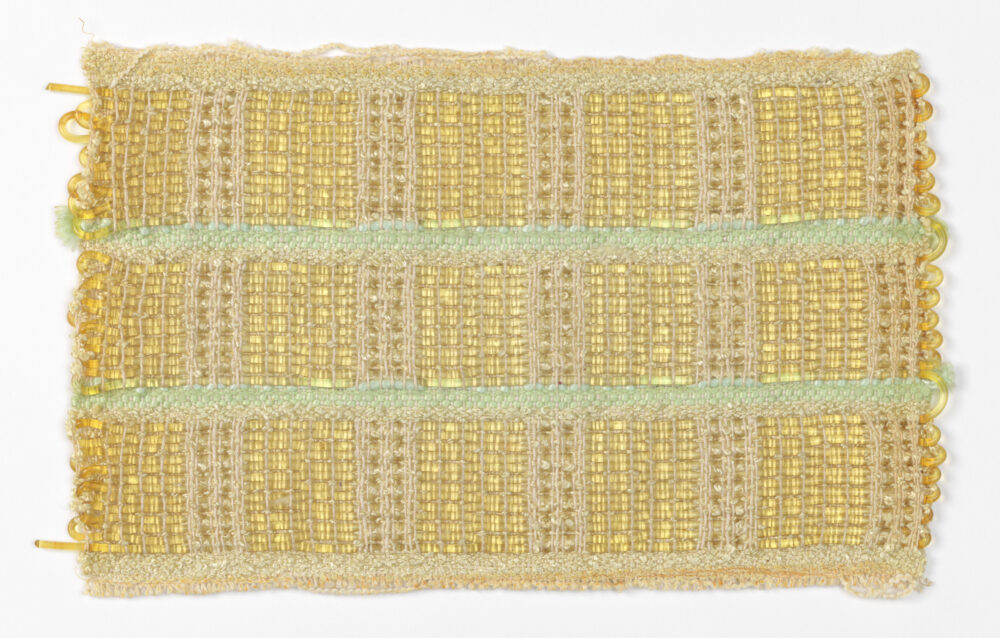
Sample, circa 1950; Designed by Dorothy Wright Liebes (American, 1897–1972); Twill-woven cotton, viscose rayon, silk, polyvinyl chloride acetate (PVC/PVA) rod; Cooper Hewitt, Smithsonian Design Museum, Gift of Mrs. Morris D. C. Crawford, 1955-71-3; Photo by Matt Flynn © Smithsonian Institution

Sample card, circa 1948; Designed by Dorothy Wright Liebes (American, 1897–1972); Twill-woven cotton, viscose rayon, silk, wool, cellulose acetate butyrate–laminated aluminum yarn; Cooper Hewitt, Smithsonian Design Museum, Gift of the Estate of Dorothy Liebes Morin, 1972-75-46; Photo by Matt Flynn © Smithsonian Institution

Sample, circa 1950; Designed by Dorothy Wright Liebes (American, 1897–1972); Twill-woven cotton, viscose rayon, silk, polyvinyl chloride acetate (PVC/PVA) rod; Cooper Hewitt, Smithsonian Design Museum, Gift of Mrs. Morris D. C. Crawford, 1955-71-3; Photo by Matt Flynn © Smithsonian Institution

Sample card, for Eagle Ottawa Leather Corp., 1958; Designed by Dorothy Wright Liebes (American, 1897–1972); Plain-woven leather; Cooper Hewitt, Smithsonian Design Museum, Gift of the Estate of Dorothy Liebes Morin, 1972-75-112; Photo by Matt Flynn © Smithsonian Institution

Sample card, for Eagle Ottawa Leather Corp., 1958; Designed by Dorothy Wright Liebes (American, 1897–1972); Plain-woven leather; Cooper Hewitt, Smithsonian Design Museum, Gift of the Estate of Dorothy Liebes Morin, 1972-75-113; Photo by Matt Flynn © Smithsonian Institution
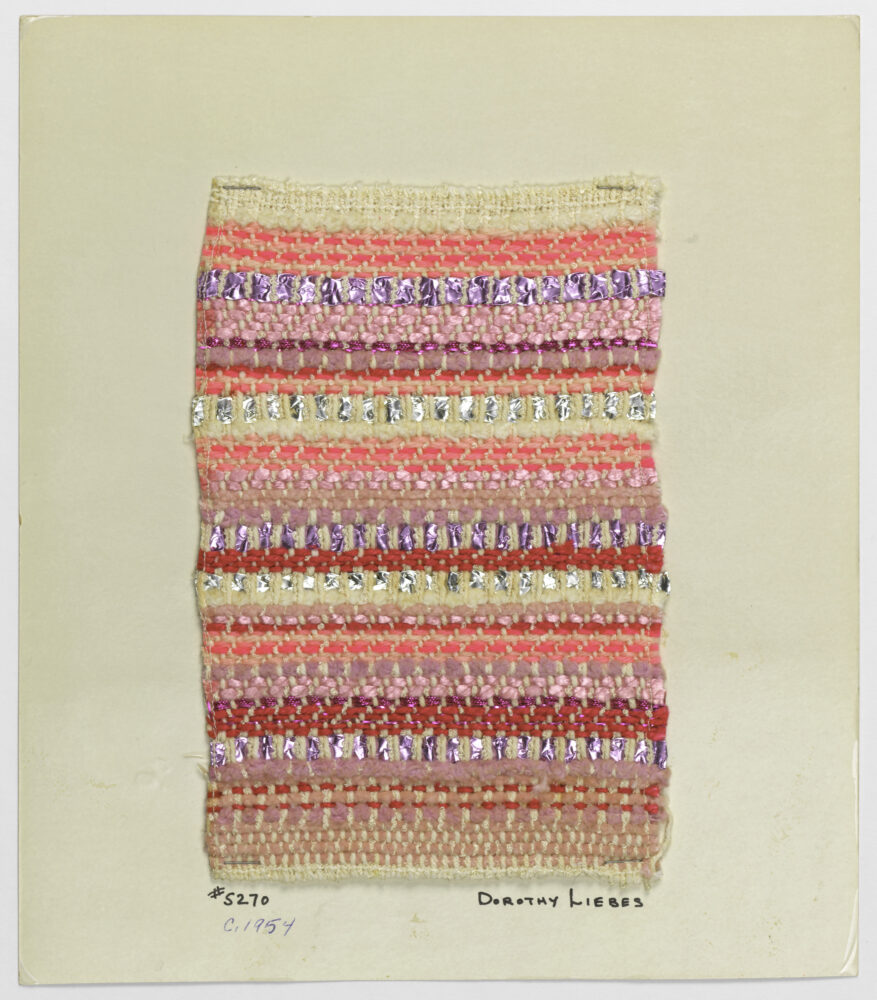
Sample card, circa 1954; Designed by Dorothy Wright Liebes (American, 1897–1972); Twill-woven cellulose acetate, cotton, viscose rayon, silk, wool, cellulose acetate butyrate–laminated aluminum yarn; Cooper Hewitt, Smithsonian Design Museum, Gift of the Estate of Dorothy Liebes Morin, 1972-75-96; Photo by Matt Flynn © Smithsonian Institution

Sample card, circa 1945; Designed by Dorothy Wright Liebes (American, 1897–1972); Plain-woven cotton, viscose rayon, silk, wool, cellophane; Cooper Hewitt, Smithsonian Design Museum, Gift of the Estate of Dorothy Liebes Morin, 1972-75-37; Photo by Matt Flynn © Smithsonian Institution

Sample card, circa 1952; Designed by Dorothy Wright Liebes (American, 1897–1972); Plain-woven cotton, viscose rayon, silk-rayon blend, cellulose acetate–laminated aluminum yarn; Cooper Hewitt, Smithsonian Design Museum, Gift of the Estate of Dorothy Liebes Morin, 1972-75-86; Photo by Matt Flynn © Smithsonian Institution

Sample card, circa 1945; Designed by Dorothy Wright Liebes (American, 1897–1972); Plain-woven cotton, viscose rayon, silk, cellophane; Cooper Hewitt, Smithsonian Design Museum, Gift of the Estate of Dorothy Liebes Morin, 1972-75-36; Photo by Matt Flynn © Smithsonian Institution

Sample for a woven blind, 1953; Designed by Dorothy Wright Liebes (American, 1897–1972); Plain-woven cotton, viscose rayon, silk, cellulose acetate– and cellulose acetate butyrate–laminated aluminum yarns, painted wood slat, polystyrene dowel; Cooper Hewitt, Smithsonian Design Museum, Gift of Titi Halle, 2021-15-16; Photo by Matt Flynn © Smithsonian Institution

Sample card, 1950–51; Designed by Dorothy Wright Liebes (American, 1897–1972); Plain-woven nylon, polyvinyl chloride, painted wood slat, polystyrene dowel; Cooper Hewitt, Smithsonian Design Museum, Gift of the Estate of Dorothy Liebes Morin, 1972-75-121; Photo by Matt Flynn © Smithsonian Institution

Sample, 1963; Designed by Dorothy Wright Liebes (American, 1897–1972); Plain-woven cotton, viscose rayon, cellulose acetate butyrate–laminated aluminum yarn, cellophane-laminated aluminum yarn, polystyrene, painted wood; Cooper Hewitt, Smithsonian Design Museum, Gift of Titi Halle, 2021-15-7; Photo by Matt Flynn © Smithsonian Institution
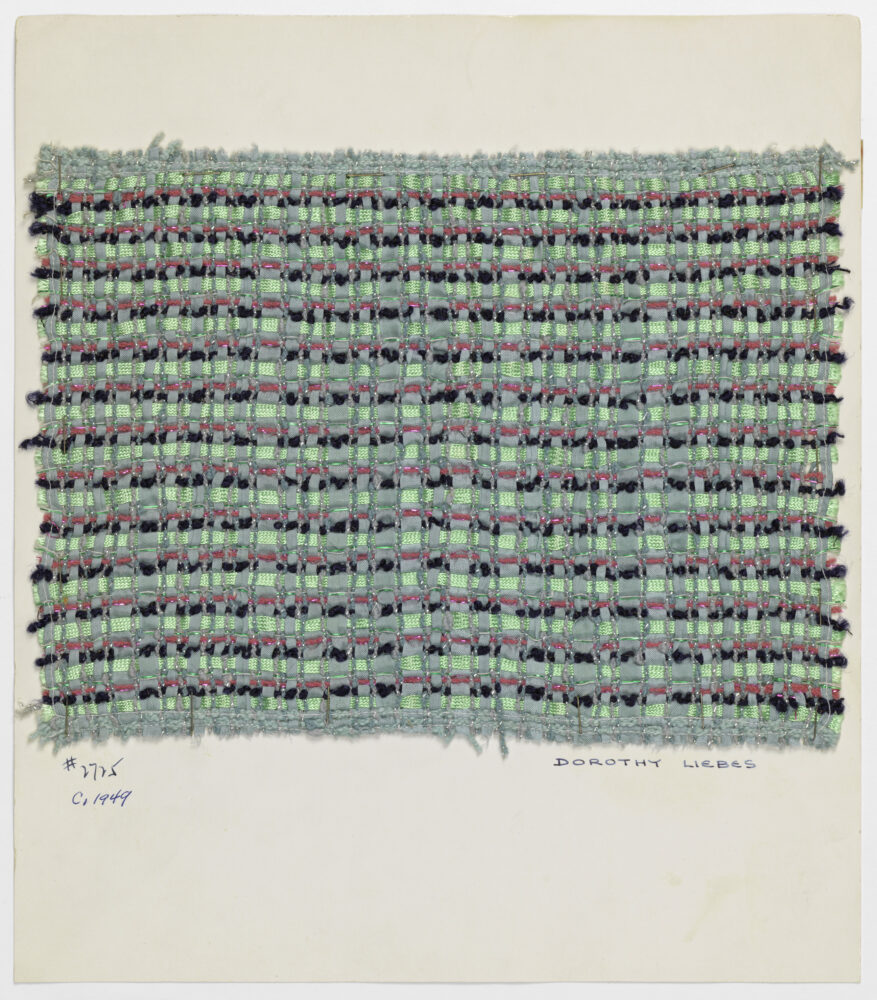
Sample card, circa 1949; Designed by Dorothy Wright Liebes (American, 1897–1972); Plain-woven cotton, linen, viscose rayon, wool, cellulose acetate butyrate–laminated aluminum yarn, copper yarn; Cooper Hewitt, Smithsonian Design Museum, Gift of the Estate of Dorothy Liebes Morin, 1972-75-73; Photo by Matt Flynn © Smithsonian Institution

Sample for a woven blind, 1952; Designed by Dorothy Wright Liebes (American, 1897–1972); Plain-woven cellulose acetate, cotton, viscose rayon, metal yarn, raffia; Cooper Hewitt, Smithsonian Design Museum, Gift of Titi Halle, 2021-15-20; Photo by Matt Flynn © Smithsonian Institution

Sample card, circa 1950; Designed by Dorothy Wright Liebes (American, 1897–1972); Plain- and twill-woven cotton, viscose rayon, silk, coated paper, cellophane- and cellulose acetate–laminated aluminum yarn; Cooper Hewitt, Smithsonian Design Museum, Gift of Mrs. Morris D. C. Crawford, 1955-71-7; Photo by Matt Flynn © Smithsonian Institution

Sample card, 1947; Designed by Dorothy Wright Liebes (American, 1897–1972); Plain- and twill-woven cotton, viscose rayon, silk-rayon blend, wool-rayon blend, cellophane; Cooper Hewitt, Smithsonian Design Museum, Gift of the Estate of Dorothy Liebes Morin, 1972-75-43; Photo by Matt Flynn © Smithsonian Institution

Sample card, 1947; Designed by Dorothy Wright Liebes (American, 1897–1972); Plain-woven with supplementary warp cotton, viscose rayon, cellulose acetate butyrate–laminated aluminum yarn; Cooper Hewitt, Smithsonian Design Museum, Gift of the Estate of Dorothy Liebes Morin, 1972-75-41; Photo by Matt Flynn © Smithsonian Institution

Sample card, circa 1954; Designed by Dorothy Wright Liebes (American, 1897–1972); Plain-woven cotton, silk, wool, wool-rayon blend, cellulose acetate butyrate–laminated aluminum yarn; Cooper Hewitt, Smithsonian Design Museum, Gift of the Estate of Dorothy Liebes Morin, 1972-75-93; Photo by Matt Flynn © Smithsonian Institution

Sample card, circa 1948; Designed by Dorothy Wright Liebes (American, 1897–1972); Twill-woven cotton, viscose rayon, silk, cellulose acetate butyrate–laminated aluminum yarn; Cooper Hewitt, Smithsonian Design Museum, Gift of the Estate of Dorothy Liebes Morin, 1972-75-53; Photo by Matt Flynn © Smithsonian Institution

Sample card, circa 1949; Designed by Dorothy Wright Liebes (American, 1897–1972); Twill-woven cotton, viscose rayon, viscose rayon-cellulose-triacetate blend, silk; Cooper Hewitt, Smithsonian Design Museum, Gift of the Estate of Dorothy Liebes Morin, 1972-75-74; Photo by Matt Flynn © Smithsonian Institution

Sample card, 1945–47; Designed by Dorothy Wright Liebes (American, 1897–1972); Plain-woven cotton, silk, coated paper, copper woven tape; Cooper Hewitt, Smithsonian Design Museum, Gift of the Estate of Dorothy Liebes Morin, 1972-75-48; Photo by Matt Flynn © Smithsonian Institution

Sample card, circa 1948; Designed by Dorothy Wright Liebes (American, 1897–1972); Plain-woven cotton, viscose rayon, silk, wool, cellulose acetate butyrate–laminated aluminum yarn; Cooper Hewitt, Smithsonian Design Museum, Gift of the Estate of Dorothy Liebes Morin, 1972-75-58; Photo by Matt Flynn © Smithsonian Institution
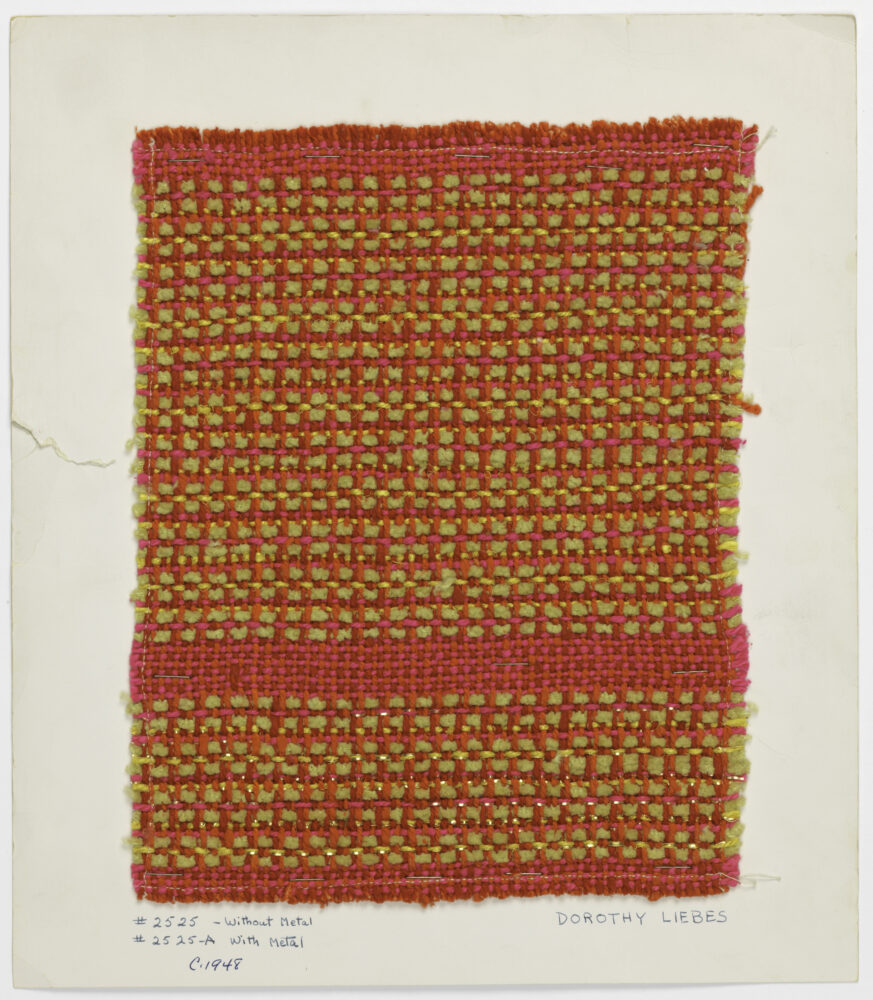
Sample card, circa 1948; Designed by Dorothy Wright Liebes (American, 1897–1972); Twill-woven cellulose acetate, cotton, silk, cellulose acetate butyrate–laminated aluminum yarn; Cooper Hewitt, Smithsonian Design Museum, Gift of the Estate of Dorothy Liebes Morin, 1972-75-66; Photo by Matt Flynn © Smithsonian Institution

Sample card, 1938–39; Designed by Dorothy Wright Liebes (American, 1897–1972); Twill-woven cotton, wool, copper yarn; Cooper Hewitt, Smithsonian Design Museum, Gift of the Estate of Dorothy Liebes Morin, 1972-75-20; Photo by Matt Flynn © Smithsonian Institution

Sample card, circa 1949; Designed by Dorothy Wright Liebes (American, 1897–1972); Twill-woven cotton, silk, cellulose acetate butyrate–laminated aluminum yarn; Cooper Hewitt, Smithsonian Design Museum, Gift of the Estate of Dorothy Liebes Morin, 1972-75-72; Photo by Matt Flynn © Smithsonian Institution

Sample card, circa 1949; Designed by Dorothy Wright Liebes (American, 1897–1972); Plain-woven cotton, viscose rayon, silk, cellulose acetate–laminated aluminum yarn; Cooper Hewitt, Smithsonian Design Museum, Gift of the Estate of Dorothy Liebes Morin, 1972-75-69; Photo by Matt Flynn © Smithsonian Institution

Sample card, circa 1942; Designed by Dorothy Wright Liebes (American, 1897–1972); Plain-woven cotton, silk, copper yarn; Cooper Hewitt, Smithsonian Design Museum, Gift of the Estate of Dorothy Liebes Morin, 1972-75-28; Photo by Matt Flynn © Smithsonian Institution
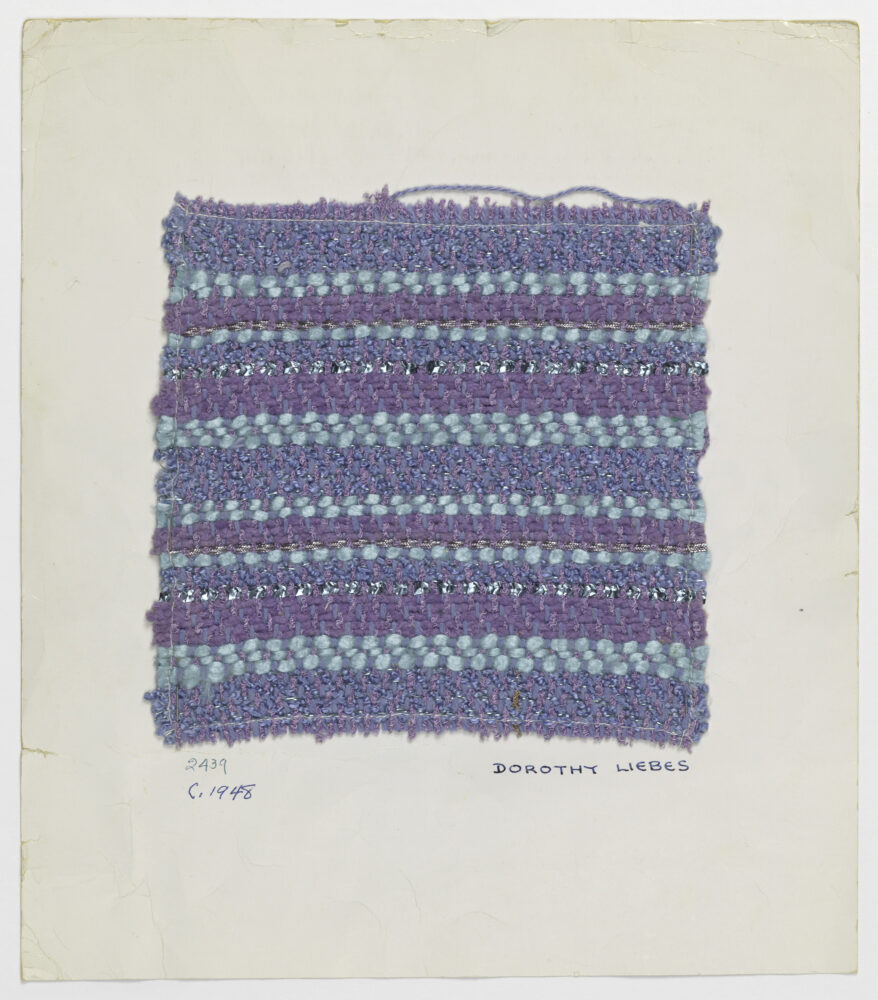
Sample card, circa 1948; Designed by Dorothy Wright Liebes (American, 1897–1972); Twill-woven cotton, viscose rayon, rayon-acetate blend, cellulose acetate– and cellulose acetate butyrate–laminated aluminum yarns; Cooper Hewitt, Smithsonian Design Museum, Gift of the Estate of Dorothy Liebes Morin, 1972-75-68; Photo by Matt Flynn © Smithsonian Institution